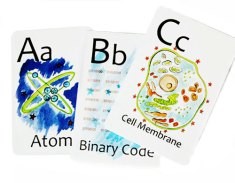It’s the giving season and there are lots of great gifts out there, but it seems ideas and decisions are in short supply. So I’m here to give some great suggestions for the scientist or science lover in your life! Based on personality type, here are the 10 best science gifts:
For the book lover, like Joanne Manaster, I recommend Wicked Bugs: The Louse That Conquered Napoleon’s Army & Other Diabolical Insects by Amy Stewart.
For the mom, like Carin Bondar, I recommend The Nerdy Baby’s ABCs Flash Cards.
For the science writer that no longer sees the inside of a lab, like Ed Yong, I recommend a nice piece of art such as Petri Dishes 5 by the talented Michele Banks.
For the marine biology lover, like Christie Wilcox, I recommend Blue Planet.
For the star gazer, like Phil Plait, I would highly recommend the book The Pluto Files by Neil deGrasse Tyson.
For the kid at heart, like Brian Krueger, I recommend a plush or bobble head famous scientist.
For the bug lover, like Bug Girl, I recommend a handmade plush insect sculpture, like the ones by Weird Bug Lady.
For the fashion forward, like Michelle Clement, I suggest a nice piece of jewelry and recommend this piece: silver DNA earrings.
For the funny one, like Brian Malow, I recommend something wearable that says: not only am I funny, I want everyone to know so I’m wearing this shirt.
For the person who has everything, like no scientist I know, a great gift would be a membership to the local science museum!
Filed under: Not Necessarily Science | Tagged: Bug Girl, DNA, Ed Yong, Neil deGrasse Tyson, Phil Plait, Pluto Files, Scientist | 3 Comments »





